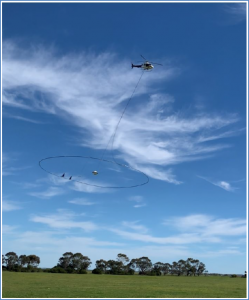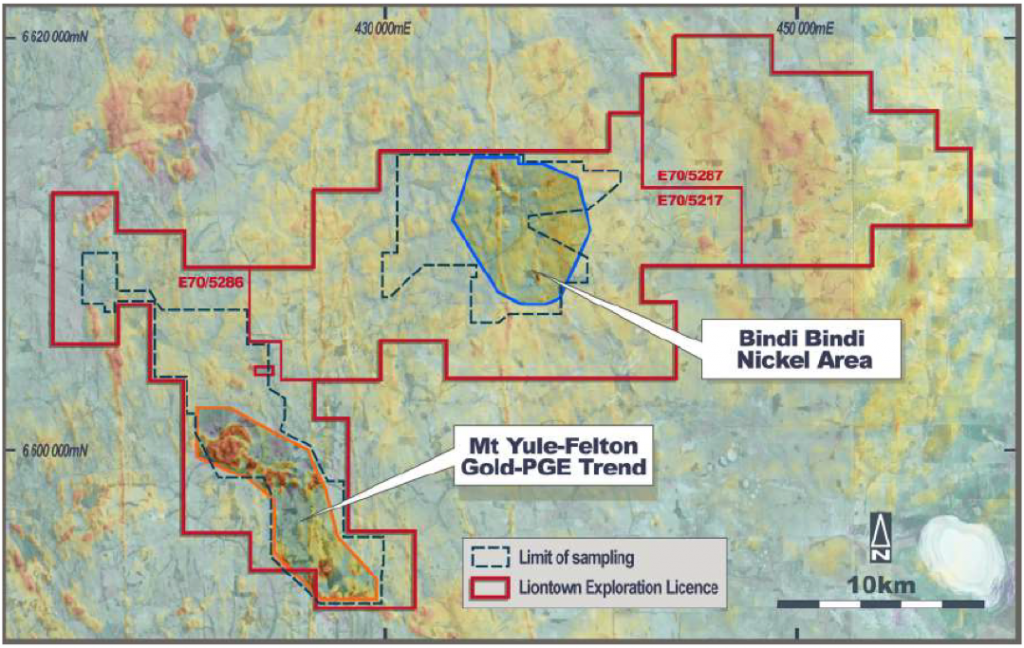Liontown Resources – (ASX: LTR, Share Price: $0.19, Market Cap: $336m – coverage initiated @ $0.025 in February 2019 – current gain of 680%)

Key Catalyst
Preliminary data from Airborne Electromagnetic survey defines a number of large, conductive zones coincident with Mt Yule – Felton Gold-PGE corridor, with a strike length of 15km.
LTR has been an outstanding market performer, with investors developing a thorough appreciation of the significance of the company’s Kathleen Valley lithium project in Western Australia, based on exceptional drilling results. The updated MRE represents a 108% increase in tonnes and 119% increase in contained lithium from the July 2019 MRE that underpinned the positive Pre-Feasibility Study (PFS) released in December 2019. The Study generated robust financial outcomes, reflecting the project’s scale, grade, product quality and proximity to established, modern infrastructure – as well as likely upside potential. These growth options will be considered as part of the revised PFS that’s scheduled for release during Q4 2020. LTR has also recently reported a maiden Mineral Resource Estimate (MRE) for its Buldania Project in Western Australia, confirming a significant new greenfields lithium discovery with growth potential.
Latest Activity
Moora Project Update
LTR has provided an exploration update with respect to ongoing exploration activity at its 100%-owned Moora Project, located ~150km north-northeast of Perth in Western Australia.
Overview
In our previous coverage of LTR during August, we highlighted the commencement of an Airborne electromagnetic (AEM) survey at its Moora Project. The commencement of the AEM survey followed recent geochemical sampling that had successfully defined large areas of highly anomalous gold-PGE-nickel-copper, coincident with magnetic and gravity anomalies. These anomalies are interpreted to be related to mafic/ultramafic intrusions that are obscured by shallow cover.
LTR has just reported that preliminary data from the AEM survey has defined a number of large, conductive zones that coincident with the previously delineated Mt Yule – Felton Gold-PGE corridor. The AEM conductors could indicate primary bedrock-hosted, sulphide zones beneath and down-dip of the surface geochemical anomalies. The Mt Yule-Felton Corridor has been defined over a length of 15km and includes multiple gold-PGE anomalies coincident with magnetic highs, interpreted to be shallow mafic-ultramafic intrusions.

Details
The Moora AEM survey was flown over the entire 467 sq km Moora project area on lines 200m apart with an average terrain clearance of 35m.
A cluster of late time (Channel 17) EM responses, indicating possible bedrock conductors, have been defined within the southwest portion of the project area. The conductive zones are broadly coincident with the Mt Yule-Felton Corridor, where shallow (<1m) auger sampling earlier this year defined strong gold and PGE anomalism, associated with elevated nickel and copper values.
The Mt Yule-Felton Corridor has been defined over a length of 15km and includes multiple gold-PGE anomalies coincident with magnetic highs, interpreted to be shallow mafic-ultramafic intrusions- with individual auger assays up to 925ppb gold (0.92g/t Au), 75ppb palladium + platinum (Pd+Pt), 492ppm nickel (Ni) and 884ppm copper (Cu); as well as multiple, +100ppb gold (0.1g/t Au) zones.
Technical Significance
The AEM survey has defined a number of strong conductors at Moora. The exploration results to date suggest that the setting and prospectivity are analogous to Chalice Gold’s (ASX: CHN) Julimar PGE-nickel-copper-gold discovery, located within the same geological terrain 95km to the south (refer to our separate cover of CHN). Electromagnetic techniques have proven to be very effective in defining sulphide zones that host the mineralisation at Julimar.
The AEM surveys follows recent auger drilling, the results of which are considered by LTR’s geological team to be exceptional for such an early stage of exploration. They have expanded previously-identified strong gold, PGE, nickel and copper anomalism, as well as defining a number of new targets, further enhancing the project’s potential.
Two highly anomalous areas have been identified:
o Firstly, the 15km long, northwest-trending Mt Yule-Felton Corridor located in the western part of the project, which is defined by the alignment of multiple, coincident gold, PGE and magnetic anomalies.
o The second area is the 7km x 7km Bindi Nickel area, located within the central part of the project, which includes a number of strong nickel anomalies.
LTR’s Managing Director, Mr David Richards, believes the auger geochemistry at Moora has produced some of the best early-stage exploration results that he had seen in his +35-year career. The coincidence of extensive high-order gold-PGE-nickel anomalism with large magnetic bodies indicates the potential for a mineralised system of significant scale.
The Mt Yule – Felton Corridor (MYFC) represents a 15km long, 2.5km wide, northwest-trending zone that contains numerous gold-PGE anomalies coincident with magnetic highs, which are indicative of near-surface, mafic-ultramafic intrusions obscured by shallow cover. The corridor transitions from being gold-dominant in the northwest to PGE-dominant in the southwest. The high gold, PGE, nickel and copper results suggest that the interpreted mafic-ultramafic intrusions within the MYFC are analogous to similar units that host the Julimar discovery ~95km south of the Moora Project.

Figure 2: Moora Project, aerial photograph over regional aeromagnetic image showing anomalous areas define by auger geochemistry.
Next Steps
The final, processed EM data, which is pending, will be used to plan ground-based moving loop EM (MLEM) surveys that will more accurately delineate potential bedrock conductors. The MLEM data will also be modelled to determine the best orientation to target follow-up RC drilling of the conductive zones.
Summary
The release of results from the AEM survey are significant as they have defined a number of strong conductors at Moora. The exploration results to date suggest that the setting and prospectivity are analogous to Chalice Gold’s (ASX: CHN) Julimar PGE-nickel-copper-gold discovery, located within the same geological terrain 95km to the south. Electromagnetic techniques have proven to be very effective in defining sulphide zones that host the mineralisation at Julimar.







